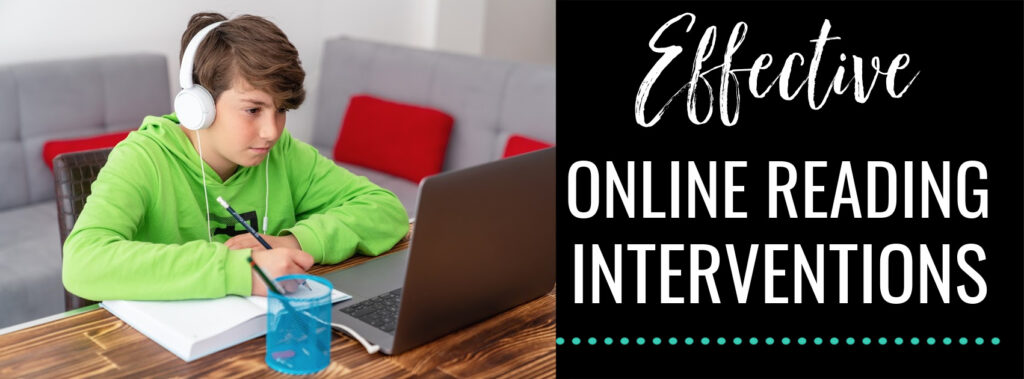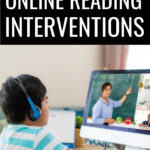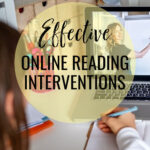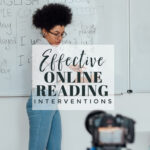This year, many of us are faced with the challenge of offering online reading interventions for our students! Oh my gosh! How do I do that? The ideas that make for effective
intervention don’t change based on the delivery system, so we need to take what we
already know and apply it in a new way. So, what are these fundamentals that we need to
reestablish in our stressed-out, on-line minds?

Before I can even begin to think about instruction or assessment, I need to really know my students. This means listening to them read while taking a running record or reading record. If you don’t know how to do this, at the very least, you need to listen and take notes while the students read a passage at their instructional reading level. After listening to a child read, I have a conversation about the story to see if they got the gist of the story. Based on that information, I make a list of strengths and needs for each student participating in the online intervention.

For the youngest children, it might mean especially noticing how they even handle a book or what they do when I read to them. I also want to collect an unassisted writing sample. Once I look at these two very natural ways of understanding readers and writers, I might need to learn more about children and do a quick check of letter and sound knowledge or sight word knowledge. If you are a classroom teacher, you may already have this information ready to analyze. If you are an interventionist, it is a good idea for you to listen to the children read yourself. Observing the reader in action can tell you as much as the data itself.

Based on this information, I can group children together considering their reading level and instructional needs. Research tells us that a group of three children is the maximum size to have a positive impact on learning when it comes to intervention. So, groups are then formed. This will help me be able to ensure that every child feels successful during the online reading intervention.
Now what about the elements of the instructional plan for an intervention? There are 9
components of effective intervention in addition to assessment. I list them here for you to consider:
Use reading intervention strategies with explicit instruction. Notice I did not say direct instruction but rather teaching explicitly. The cycle of teacher modeling, doing the skill together, and then practicing that same skill on their own is optimal for building confidence and focusing on exactly the skill or strategy... even in an online environment!
Use routines in your students online reading interventions. Students, especially those who struggle, thrive on routine. When they know exactly what they need to do each time, there will be less time lost in explaining directions and they will feel confident in knowing what they need to be doing. Instruction will be efficient, and student engagement will be up.
Read as much as possible. A huge principle in building any skill, is you get better at what you practice. Other online reading intervention activities absolutely have value and are of paramount importance, but the #1 skill we are trying to build is reading text, so why not spend a lot of time reading?

Use digital read alouds interactively to model good reading. Online reading interventions should include screen sharing in order to model while you read aloud. People don’t realize how priceless read alouds are when they are interactive.
Use real digital books along with reading passages and instructional materials. Children in online intervention groups need to see that they can use the skills and strategies you are teaching in any kind of materials.
Mix up student choice and teacher selected reading. Choice increases motivation because they get to pick what they want to read. They can read about their interests at levels they feel comfortable reading.

Students need the opportunity to read at both their independent and instructional levels. Books should not be hard, ever! When learning something new, using easy texts gives the children the opportunity to think about the new “thing they are learning” and not whether “I know all the words”.
Help every child feel successful. Don’t forget the importance of early intervention and staying positive. When students feel defeated, their motivation plummets. Intervening as soon as possible after a concern is identified, prevents that defeated feeling.
Break the lesson time of about 30 minutes of instructional time into smaller chunks. ONLINE INTERVENTIONS REQUIRE A LOT OF TWEAKING! Don’t overlook this tip on this reading intervention list. Sometimes (maybe more than sometimes) students have a hard time staying focused during long lessons.
Watch for the next post I have for you regarding intervention. I will offer suggestions of
instructional activities in each of the domains of reading.



[…] teachers across the world! Let’s look at applying the nine principles about intervention from my other posts on intervention to the five domains of reading. The principles are:♥Provide explicit instruction♥Following […]